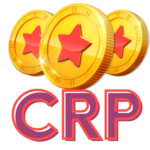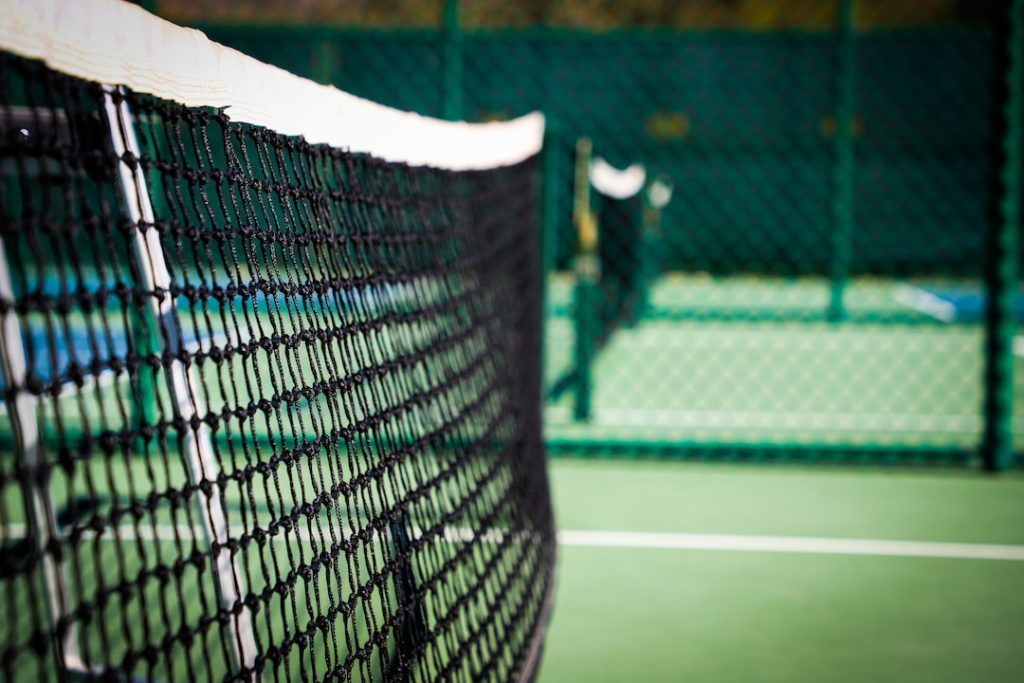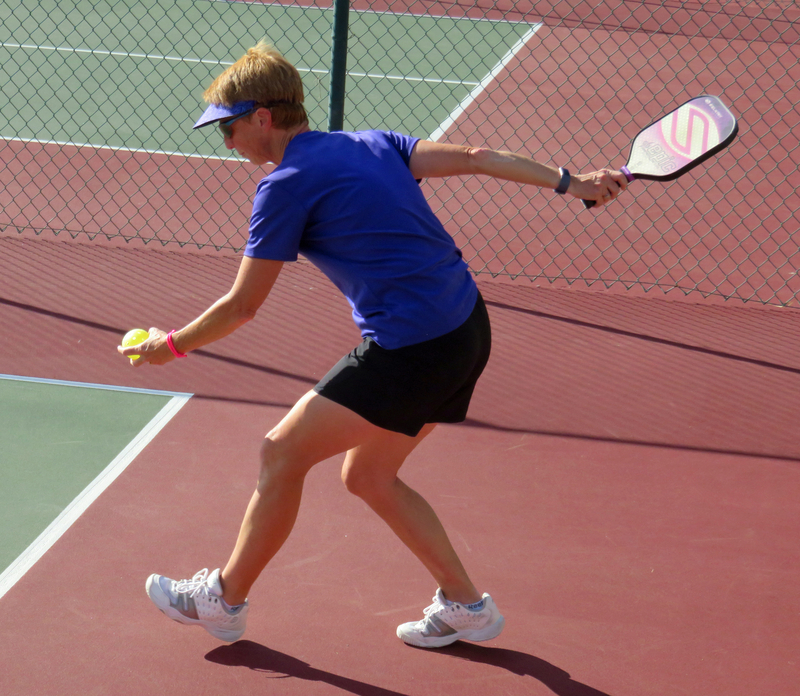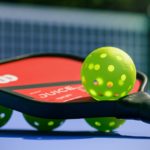A seasoned pickleball player will understand the importance of having a strong and consistent serve. A well-executed serve can provide a competitive edge over opponents from the outset of play. From mastering the basics to more advanced strategies, this blog post will equip pickleball players with all the information, they need on how to serve in pickleball and take their serve game to the next level.
From practicing drills to mastering different types of serves like drop and volley serves, we’ve got you covered with all the information you need to become a formidable opponent on any court. Want to learn how to serve in pickleball? Let’s get started!
Table of Contents
Perfecting Your Pickleball Serve
A strong serve is essential for success in pickleball. It’s important to know the two main grips used when serving: the Eastern Grip and Handshake Grip.
The Eastern Grip is a variation of an open stance, where your non-paddle side foot should be pointing towards the opponent’s court while your paddle hand forms a V shape with your index finger and thumb pointed up. The Handshake Grip is similar to the Eastern grip, but you hold your paddle like you would shake hands with someone.
When channeling your inner Bruce Lee, make sure you use quick movements and accurate placement for each shot. This will help keep opponents guessing which direction you will hit next. To practice this technique, try alternating between forehand shots and backhand serves from different angles on both sides of the court until it becomes second nature.
Serving deep can also be incredibly helpful when trying to score points in pickleball games. Driving serves straight down into the service box or across the court can quickly force opponents out of a position and give you an advantage during rallies. When attempting a deep serve, ensure all parts of your body remain relaxed, as tension can lead to inconsistent shots or illegal serves due to incorrect player positioning at contact time with ball hits.
Finally, lobbying can also be an effective way to get points if done correctly. Ensure that all parts of your body remain balanced throughout the motion so that power isn’t sacrificed during contact time with ball hits; this will help ensure consistent lobs every time. Additionally, remember not to cross over into any non-volley zone lines as this could result in a loss of point(s) according to official rules – even if no one notices.
Practicing the right technique and mastering different types of serves is essential to becoming a successful pickleball player. Let’s examine the techniques for honing different serves in pickleball.
Mastering Different Types of Serves in Pickleball
Pickleball has been becoming increasingly popular lately, garnering more attention and participation. Mastering the different types of serves can give you an edge over your opponents and help you gain an advantage over them during gameplay.
The Traditional Volley Serve is one of the pickleball’s most common pickleball serving techniques. This type of serve requires the player to hit the ball with their paddle while it’s still in mid-air before it bounces off the ground or court surface. To successfully execute this serve, players must time their swing perfectly to make contact with the ball at the right moment.
Additionally, players should aim for power and accuracy when making contact with the ball and maintain proper posture throughout their motion to ensure maximum control over their shots.
The Drop Serve is another popular technique used by experienced pickleball players who are looking to mix up their game plan and surprise their opponents. This type of serve aims to hit a soft shot that lands close to where your opponent stands after bouncing off either side of your court surface once or twice before reaching them. Players should keep in mind that drop serves require more finesse than traditional volley serves since they involve aiming for precision rather than power when making contact with the ball.
Additionally, mastering this technique also involves knowing how much spin needs to be applied depending on where you want your shot to land – whether it’s near or far from your opponent’s feet.
If a player fails to execute either the traditional volley or drop serve twice consecutively, they will be penalized with a point against them. Furthermore, if any part of their body other than their hand touches the net during an attempted service, a point is also awarded against them.
In addition, regardless of whether the serve was successful or not due to an unforced error, a point goes against the server.
Lastly, should there be a let call during an attempt at serving, again, the same rule applies, and points are counted against the server in such cases. As such, players must stay on top of their game by being mindful of these rules and exercising caution when attempting serves to avoid incurring penalties that could potentially cost them dearly in matches.
These rules are important for both novice and veteran pickleballers alike. Understanding them can help prevent unnecessary mistakes, which could potentially cost someone valuable points during competitive matches. By staying mindful of these regulations and exercising caution when attempting serves, players can ensure that they don’t incur any penalties that could ultimately be detrimental to their performance in a match.
Mastering different types of serves in pickleball is an important skill to develop, as it can help you gain the upper hand during a match. Proper positioning on the court will make your serve even more effective and powerful.
Positioning Yourself on Court During Playtime
Positioning yourself on the court during playtime is essential to a successful match. Knowing where you can and cannot stand when serving or volleying is key to staying within pickleball rules.
Foot Faults
It’s important to keep your feet behind the baseline while serving; otherwise, it’s considered a foot fault and results in an automatic point for your opponent. When returning shots, players must remain within the center line/sideline limits as crossing over either will also result in a foot fault penalty.
If this happens, make sure to apologize quickly, as good sportsmanship goes a long way.
Wrong Player Serves
Another thing to remember is that only one player from each team can serve at any given time; if both players from one team are standing at the service line, then it’s considered wrong if a player serves and results in another point for their opponents. Make sure you know who’s up before stepping into the position.
A let serve occurs when an unexpected distraction occurs, such as someone walking onto the court during play or loud noises coming from outside sources like traffic or construction sites nearby. This would cause the ball not to be served correctly, resulting in a do-over called “let serves” by referees. In these cases, take deep breaths and focus on getting back into game mode after taking some time away from playing due to these distractions.
Positioning yourself on the court during playtime is essential for a successful game of pickleball. It’s important to understand the foot faults and wrong player serves and let serve rules before you begin your serve.
With this knowledge in hand, it’s time to mix up different pickleball serving methods during gameplay, such as the high soft serve vs. high slow arc or using an effective serving strategy.
Mixing Up Different Ways of Serving During Gameplay
Serving is an essential part of pickleball, and mastering different types of serves can give you an edge over your opponents. When playing pickleball, mixing up your serving style to keep your opponents guessing is important. Varying the kind, placement, and velocity of your serves can give you a competitive edge on the pickleball court.
The first way to mix up your serves during gameplay is by using a high soft serve versus a high slow arc. The difference between these two styles lies in how much power is behind them when they are hit. A high soft serve requires less force than a high slow arc; however, both require precision and accuracy for them to be effective.
With a high soft serve, you want to aim for short angles near the net so that it will land just inside or outside the service line before bouncing off into the play area. On the other hand, with a high slow arc shot, players should focus on hitting deep shots towards their opponent’s backcourt instead since this will put more pressure on them while also giving you time to reposition yourself closer towards center court if needed.
If your adversary expected you to hit another hard smash, then changing the game up with a drop shot or lob can throw them for a loop and give you the upper hand. This will provide an opening for you to put some distance between yourself and your opponent while creating more chances of successful returns later on.
Serving in pickleball is an important skill to master, and by mixing up different ways of serving during gameplay, you can gain a competitive edge. By honing your practice drills and routines, you can ensure a successful performance during the next match.
Preparing For Your Next Match With Practice Drills And Routines
Practicing drills is essential for pickleball players who want to become better at their game. Drills help with accuracy, consistency, and timing, as well as improving overall performance levels. A semi-closed stance helps generate more paddle speed and allows the player to lift the ball before releasing it.
To up your game, mix some drills into your warm-up, varying between gentle lobs and hard serves, drop shots, or speedy arcs to surprise the opposition. Alternating between high soft serves and high slow arcs is a great way to practice controlling the power of your serve and hone in on precision.
Mixing it up with fast, hard serves, lob shots, or drop shots will keep your opponent guessing as you show off your court savvy during matches. By putting these skills into action, you can hit the ground running and soar like an eagle.
Another helpful drill is known as “the four corners” drill, which involves standing in each corner of the court while practicing hitting different types of serves into all four corners consecutively without missing any shots or having them land out-of-bounds. This exercise will help improve accuracy and aim when trying to hit specific spots on the court with serves during actual games, especially when going up against opponents who have good returns and won’t let anything pass by them easily.
FAQs in Relation to How to Serve in Pickleball
How do you serve effectively in pickleball?
It is important to focus on accuracy and power to serve effectively in pickleball. Drill your aim to ensure you can hit the ball accurately where intended. It is also essential to develop a powerful swing so that you can generate enough force behind the ball when serving.
Additionally, be sure to keep your feet planted firmly on the ground, as this will help with balance and control during service.
Finally, always practice proper technique for each type of serve; doing so will ensure consistency in both placement and speed of shots served.
What are the 5 serving rules in pickleball?
1. Hit the ball with enough force to enable your adversary to return it.
2. Don’t crowd the kitchen. The non-volley zone (or “kitchen”) must always be clear; no one should ever enter this area while volleys are being exchanged or during a serve.
3. Use an underhand stroke. All shots must be made with an underhand swing from below waist level, which helps ensure safety for both players involved in a match.
4. Respect court boundaries. Pickleball courts have specific lines marking their borders, and each player needs to stay within these bounds when hitting shots or making returns over the net – otherwise, points will not count.
5 . Avoid foot faults. Players cannot step into either service box before striking a serve across; if they do so, then any resulting shot will not count towards scoring as well as result in a loss of points for that player
What are the 3 rules of a pickleball serve?
1. The server must stand behind the baseline on their side of the court and hit the ball diagonally across to the opponent’s service area.
2. A pickleball serve must be made underhand, with an open paddle face and contact below waist level in a continuous motion without pausing or stalling at any point before or during delivery.
3. After serving, players may not step into either non-volley zone until after their opponents have returned the ball back over the net (the “kitchen line”).
Conclusion
How to serve in pickleball? No matter which serve you choose to use in pickleball, the most important thing is that it gets your opponent off balance. It’s also essential to practice each of these regular serves so that they become second nature when playing a match. With enough dedication and focus on technique, anyone can master their own style of serving in pickleball. Leave a review for a $5 Gift card!







